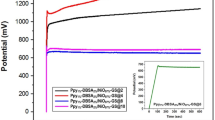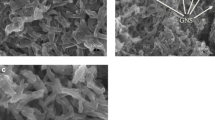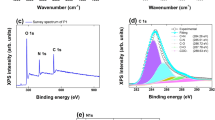Abstract
High-performance supercapacitors require the molecular-level linkage of charge transport components and charge-storage components. In this work, polypyrrole (PPy) was prepared via in situ chemical oxidative polymerization in the presence of a reactive dye (alizarin red S, ARS) which could play the role of both dopant and physical cross linker for pyrrole polymerization. The effects of ARS concentration on morphology, structure, electrical conductivity, and electrochemical performance were studied. When the feeding ratio of pyrrole: ARS was 2:1, the as-prepared ARS-doped PPy sample exhibited a high-mass-specific capacitance of 319 F/g at a current density of 1.0 A/g. All PPy–ARS electrodes possessed excellent capacitance retention. Especially, the specific capacitance of the sample with the highest ARS content increased by 18% of its initial value after 2000 cycles. The results demonstrated that the multifunctional dye ARS could effectively improve the performances of PPy as an electrode material for supercapacitors.










Similar content being viewed by others
References
Xiao FS, Yang Z, Zhang H et al (2015) Scalable synthesis of freestanding sandwich-structured graphene/polyaniline/graphene nanocomposite paper for flexible all-solid-state supercapacitor. Sci Rep 5:9359
Radja I, Djelad H, Morallon E et al (2015) Characterization and electrochemical properties of conducting nanocomposites synthesized from p-anisidine and aniline with titanium carbide by chemical oxidative method. Synth Met 202:25–32
Chouli F, Zehhaf A, Benyoucef A (2014) Preparation and characterization of the new conducting composites obtained from 2-methylaniline and Aniline with activated carbon by in situ intercalative oxidative polymerization. Macromol Res 22:26–31
Tang H, Wang J, Yin H (2015) Growth of polypyrrole ultrathin films on MoS2 monolayers as high-performance supercapacitor electrodes. Adv Mater 27:1117–1123
Benykhlef S, Bekhoukh A, Berenguer R et al (2016) PANI-derived polymer/Al2O3 nanocomposites: synthesis, characterization, and electrochemical studies. Colloid Polym Sci 294:1877–1885
Gürbüz O, Filiz B, Orhan Ş et al (2016) Structural, optical and electrical properties of polypyrrole in an ionic liquid. Polym Bull. doi:10.1007/s00289-016-1856-3
Dahou FZ, Khaldi MA, Zehhaf A et al (2016) Nanocomposite of 2-aminophenol with aniline using copper-montmorillonite: synthesis, characterization, conductivity, and electrochemical study. Adv Polym Tech 35:411–418
Davoglio RA, Biaggio SR, Bocchi N et al (2013) Flexible and high surface area composites of carbon fiber, polypyrrole, and poly (DMCT) for supercapacitor electrodes. Electrochim Acta 93:93–100
Zhao H, Hou L, Lu Y (2016) Electromagnetic shielding effectiveness and serviceability of the multilayer structured cuprammonium fabric/polypyrrole/Copper (CF/PPy/Cu) composite. Chem Eng J 297:170–179
Kim YY, Yun J, Kim HI et al (2012) Effect of oxyfluorination on electromagnetic interference shielding of polypyrrole-coated multi-walled carbon nanotubes. J Ind Eng Chem 18:392–398
Lee JS, Jun J, Shin DN et al (2014) Urchin-like polypyrrole nanoparticles for highly sensitive and selective chemiresistive sensor application. Nanoscale 6:4188–4194
Okuzaki H, Kuwabara T, Funasaka K, Saido T (2013) Humidity-sensitive polypyrrole films for electro-active polymer actuators. Adv Funct Mater 23:4400–4407
Zheng WG, Alici R, Clingan BJ et al (2013) Polypyrrole stretchable actuators. J Polym Sci Pol Phys 51:57–63
Yang C, Zang LM, Qiu JH et al (2014) Nano-Cladding of natural microcrystalline cellulose with conducting polymer: preparation, characterization, and application in energy storage. RSC Adv 4:40345–40351
Lang XQ, Wan C, Feng X et al (2010) The role of anthraquinone sulfonate dopants in promoting performance of polypyrrole composites as pseudo-capacitive electrode materials. Synth Met 160:1800–1804
Herrmann S, Aydemir N, Nägele F et al (2017) Enhanced capacitive energy storage in polyoxometalate-doped polypyrrole. Adv Funct Mater. doi:10.1002/adfm.201700881
Milczarek G, Inganas O (2012) Renewable cathode materials from biopolymer/conjugated polymer interpenetrating networks. Science 335:1468–1471
Yang C, Liu P (2009) Water-dispersed conductive polypyrroles doped with lignosulfonate and the weak temperature dependence of electrical conductivity. Ind Eng Chem Res 48:9498–9503
Halls JE, Ahn SD, Jiang D et al (2013) Proton uptake vs. redox driven release from metal-organic-frameworks: alizarin red s reactivity in Umcm-1. J Electroanal Chem 689:168–175
Zhu Y, Shi K, Zhitomirsky I (2014) Anionic dopant-dispersants for synthesis of polypyrrole coated carbon nanotubes and fabrication of supercapacitor electrodes with high active mass loading. J Mater Chem A 2:14666–14673
Zang LM, Qiu JH, Yang C et al (2015) Enhanced conductivity and electrochemical performance of electrode material based on multifunctional dye doped polypyrrole. J Nanosci Nanotechnol 16:2564–2570
Yalçınkaya S, Demirbilek C, Özdemir Dinç C (2015) Preparation and characterization of polypyrrole/dextran sulphate composite: its electrochemical and thermal behaviors. Polym Bull 72:2843–2855
Lang XQ, Wan C, Feng X et al (2010) The role of anthraquinone sulfonate dopants in promoting performance of polypyrrole composites as pseudo-capacitive electrode materials. Synth Met 160:1800–1804
Wan QY, Fan SS, Yue XJ et al (2010) Improved capacitive performance of polypyrrole doped with 9,10-anthraquinone-2-sulfonic acid sodium salt. Acta Phys Chim Sin 26:2951–2956
Sun W, Zhou Y, Su Q et al (2016) Removal Of chromium (VI) from aqueous solutions using polypyrrole-based magnetic composites. Polym Bull. doi:10.1007/s00289-016-1769-1
Zang LM, Qiu JH, Yang C et al (2015) In situ preparation of polypyrrole nanorod composite in the presence of phosphorylated polyvinyl alcohol. Adv Polym Technol. doi:10.1002/adv.21497
Moriguchi T, Yano K, Nakagawa N et al (2003) Elucidation Of adsorption mechanism of bone-staining agent alizarin red s on hydroxyapatite by Ft–Ir microspectroscopy. J Colloid Interface Sci 260:19–25
Moulder JF (1995) Handbook of X-ray photoelectron spectroscopy: a reference book of standard spectra for identification and interpretation of xPS data. Physical Electronics, Chanhassen, pp 40–56
Kim DY, Lee JY, Kim CY et al (1995) Difference in doping behavior between polypyrrole films and powders. Synth Met 72:243–248
Mondal S, Sangaranarayanan MV (2015) A novel, rapid synthetic protocol for controllable sizes, conductivities and monomer units of soluble polypyrrole. Eur Polym J 71:596–611
Luo JJ, Lu QF (2015) Controllable preparation and heavy-metal-ion adsorption of lignosulfonate-polypyrrole composite nanosorbent. Polym Compos 36:1546–1556
Xing S, Zhao G (2006) Morphology And thermostability of polypyrrole prepared from SDBS aqueous solution. Polym Bull 57:933–943
Taunk M, Kapil A, Chand S (2011) Chemical synthesis and low temperature electrical transport in polypyrrole doped with sodium bis(2-ethylhexyl) sulfosuccinate. J Mater Sci Mater Electron 22:136–142
Omastova M, Trchova M, Pionteck H et al (2004) EFfect of polymerization conditions on the properties of polypyrrole prepared in the presence of sodium bis(2-ethylhexyl) sulfosuccinate. Synth Met 143:153–161
Yang C, Wang X, Wang Y et al (2012) Polypyrrole nanoparticles with high dispersion stability via chemical oxidative polymerization in presence of an anionic–non-ionic bifunctional polymeric surfactant. Powder Technol 217:134–139
Algharaibeh Z, Liu X, Pickup PG (2009) An asymmetric anthraquinone-modified carbon/ruthenium oxide supercapacitor. J Power Sources 187:640–643
Kalinathan K, DesRoches DP, Liu X et al (2008) Anthraquinone modified carbon fabric supercapacitors with improved energy and power densities. J Power Sources 181:182–185
Bard AJ, Fualkner LR (2000) Electrochemicalmethods: fundamentals and applications, 2nd edn. Wiley, Hoboken
Acknowledgements
This work was supported by the National Natural Science Foundation of China (51303035); the Foundation of Key Laboratory of Biomass Chemical Engineering of Ministry of Education, Zhejiang University (2015BCE005); and the Collaborative Innovation Center for Exploration of Hidden Nonferrous Metal Deposits and Development of New Materials in Guangxi.
Author information
Authors and Affiliations
Corresponding author
Rights and permissions
About this article
Cite this article
Zang, L., Liu, Q., Yang, C. et al. Alizarin red: a reactive dye to enhance nanoengineered polypyrrole with high electrochemical energy storage. Polym. Bull. 75, 3311–3323 (2018). https://doi.org/10.1007/s00289-017-2211-z
Received:
Revised:
Accepted:
Published:
Issue Date:
DOI: https://doi.org/10.1007/s00289-017-2211-z




